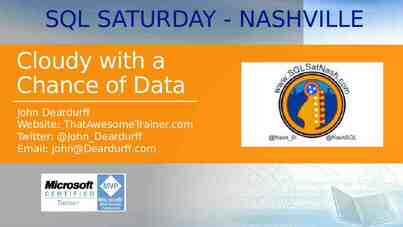Creative Thinkers Wanted Introducing AP® Computer Science Principles
18 Slides5.19 MB
Creative Thinkers Wanted Introducing AP Computer Science Principles
Myth vs. Reality MYTH: Computer Science is all about word processing, sending email, and using the Internet. REALITY: While computer science makes those things possible, it’s less about using specific applications than using the computer to address problems through new applications. MYTH: Computer science consists of sitting in front of a computer by yourself, coding for hours on end. REALITY: Computer science is creative and collaborative! Computers are elaborate tools for solving real-world problems, and teamwork is essential to developing those solutions. MYTH: When I think of computer science, the only career that comes to mind is programming. REALITY: Studying computer science can lead to hundred of career paths, including 3-D animation, engineering, entertainment, app development, medicine, visual design, robotics, political analysis and much, much more. 2
Myth vs. Reality MYTH: Computer science is only for boys. REALITY: Computer science is for everyone. Boy or girl, if you are creative, like to work in a team, and are interested in how technology can solve problems, computer science is for you. MYTH: I’m not good at math, so I won’t be good at computer science. REALITY: Like all sciences, computer science does involve math, but not everything is 1s and 0s. Language skills and critical thinking are just as, if not more, important for success. 3
What do celebrities and peers say about computer science? Note: Present one or more videos from code.org – students celebrating the empowerment of coding. Computer Science Matters – Starring Bill Gates, Mark Zuckerberg, Makinde Adeagbo, Karlie Kloss, Kevin Systrom, Paola Meija Minaya, Drew Houston, and President Barack Obama Karlie Kloss: Coding is a superpower NBA start Chris Bosh on Computer Science 4
What is AP Computer Science Principles (AP CSP)? Did you know that of the more than 9 million STEM jobs available in the next decade, half will require computing experience? AP CSP, launching in fall 2016, prepares you by: Introducing you to the essential ideas of computer science. Challenging you to explore how computing and technology impact the world around you. Providing a foundation of knowledge that can be applied across disciplines, no matter what your major or career focus- from STEM fields to music and the arts. Chances are, no matter what field you’re interested in, computers play a role. 5
What makes AP CSP special? Creatively address world issues and concerns Use the same processes and tools as artists, musicians, engineers, computer scientists and others to bring ideas to life Conceptualize and build digital projects, such as videos or mobile apps, that have practical, real-world use Learn how to identify threats to cybersecurity and ways to use the internet to address such concerns “AP Computer Science Principles opened my mind to just about everything. I learned that computer science and programming is not just for some people — it’s for anybody.” — Mikiyah Smith, Sophomore 6
What do my peers say about AP CSP? Note: Present one or more videos from The College Board YouTube Channel at www.youtube.com/advancedplacement featuring students and teachers talking about the value of AP CSP. Introducing AP Computer Science Principles Explore AP CSP: Hamed expresses himself through code Explore AP CSP: Kaila reveals self-created travel app Explore AP CSP: Lily introduces ABC’s app for kids 7
What do my peers say about AP CSP? Students who took AP CSP in pilot schools say the course Gives the autonomy to pursue their passion Prepares for many different jobs in the future Gives freedom to select computing innovations they want to investigate Allows students to collaborate with peers to solve problems Leads to may creative possibilities 8
How is this course different from AP Computer Science A? 9 Computer Science A Computer Science Principles What it’s about Programming and problem solving using the Java language The fundamentals of computing, including problem solving, working with data, understanding the Internet, cybersecurity, and programming Goal Developing your skills for future study or a career in computer science or other STEM fields Broadening participation in computer science and other STEM fields by exposing you to multiple aspects of computing The exam One end-of-year exam: multiple choice and free-response Two projects (one written and one computer-based) during the course One end-of-year exam: multiplechoice
What does the course cover? Creativity Create a computational artifact for creative expression. Abstraction Explain how binary sequences are used to represent digital data. Data and Information Extract information from data to discover and explain connections, patterns, or trends. 10
What does the course cover? Algorithms Express an algorithm in a language. Global Impact Analyze the beneficial and harmful effects of computing. 11 Programming Collaborate to develop a program. The Internet Explain characteristics of the Internet and the systems built on it.
What does the AP exam cover? Part I: Through-Course Assessments 1. Upload digital artifacts (e.g., a video, spreadsheet, graph, app, electronic slide show) and written responses via a Web-based digital application. 2. Describe or analyze your work, whether it includes research, the creation of a digital artifact, or the creation of a program. Part II: End-of-Course AP Exam Paper and pencil written exam 120 minutes with 74 multiple choice questions First administration May 2017 12
Which institutions already recognize this course? Colleges and universities are currently establishing credit and placement policies. The list of institutions that will recognize this course will continue to grow. Auburn University Duke University North Carolina State University Bryn Mawr College Florida International University Oakland University Cal Poly State University San Luis Obispo George Mason University Oklahoma State University Carleton College Georgia Tech Portland State University Carleton University Harvard University Princeton University Carnegie Mellon University Illinois Institute of Technology Rice University Case Western Reserve University Indiana University Rose-Hulman Institute of Technology College of William and Mary Kalamazoo College Saint Louis University Colorado School of Mines Lawrence Technological University Saint Xavier University Columbia University Lehigh University Seattle University Cornell University Loyola University Chicago Southwestern University DePaul University Marquette University Texas A&M University Doane College Metropolitan State College of Denver Texas State University San Marcos Drexel University Middlebury College The College at Brockport (SUNY) New Mexico State University Towson University 13
Which institutions recognize this course? Trinity College University of Illinois University of Texas at San Antonio United States Naval Academy University of Illinois at Chicago University of Virginia University at Albany (SUNY) University of Kentucky University of Washington University of Alabama University of Maryland Baltimore County University of Washington Tacoma University of Arizona University of Massachusetts Amherst University of Wisconsin Madison University of British Columbia University of Memphis Virginia Tech University of California Berkeley University of Michigan Wake Forest University University of California Davis University of Minnesota Washington State University University of California Irvine University of Nebraska Lincoln Wellesley College University of California Los Angeles University of New Hampshire Western Washington University University of California Santa Barbara University of New Hampshire Manchester Williams College University of California Santa Cruz University of North Carolina Chapel Hill University of Virginia University of Central Arkansas University of North Carolina Charlotte University of Washington University of Central Florida University of North Carolina Greensboro University of Washington Tacoma University of Cincinnati University of North Florida University of Wisconsin Madison University of Colorado at Boulder University of Oklahoma Wake Forest University University of Connecticut University of Pennsylvania Washington State University University of Delaware University of Puget Sound Wellesley College University of Georgia University of Rochester Western Carolina University University of Houston University of South Carolina Western Washington University 14
What college majors can you pursue with computing? Colleges and universities offer many majors that make use of computing, like: Aerospace Engineering Applied Physics Astronomy Botany Business Administration Chemical Engineering Civil Engineering Computer Engineering Computer Forensics Computer Graphics Computer Science Economics collegeboard.org/CSP 15 Education Electrical Engineering Electronics Technology Environmental Studies Geography Geology Industrial Engineering Information Science Information Technology Linguistics Management Information Systems Marine Biology Mathematics Mechanical Engineering Molecular Biology Neuroscience Nuclear Engineering Physics Robotics Technology Statistics Studio Arts Web Development Zoology
What can your future be like? Taking AP Computer Science Principles can lead to a future in over 100 careers. Advertising Manager Aerospace Engineer Aircraft Pilot Architect Art Director Astronomer Biomedical Engineer Chemical Engineer Coach Computer Programmer Editor Economist collegeboard.org/CSP 16 Electrical Engineer Dentist Forensic Scientist Financial Manager General Practitioner Geoscientist Graphic Designer Market Researcher Mathematician Medical Scientist Meteorologist Multimedia Artist and Animator Nuclear Engineer News Analyst, Reporter Pharmacist Physical Therapist Psychiatrist Real Estate Broker Statistician Surgeon Technical Writer Translator Veterinarian Web Designer
Take the next step Visit collegeboard.org/CSP to learn more Completing an Algebra 1 course is highly recommended Speak to your AP coordinator or counselor about how to enroll Consider taking the course with a friend Previous experience with coding is not required to be successful in this course. A home computer, while a good idea, is not required to take this course. 17
Create The Future























